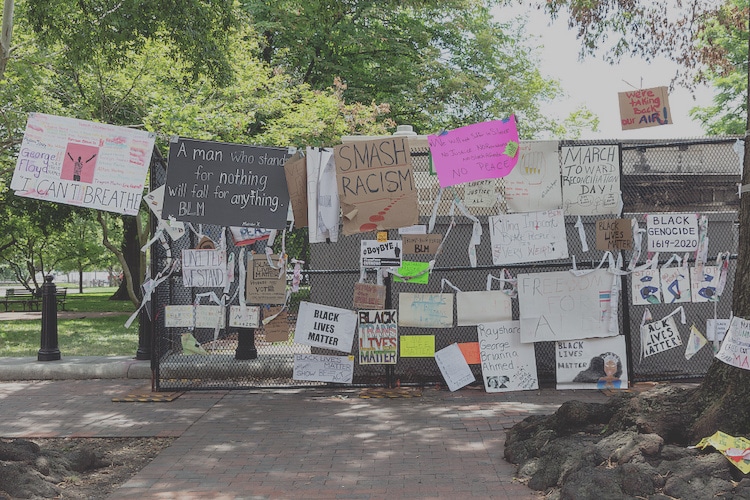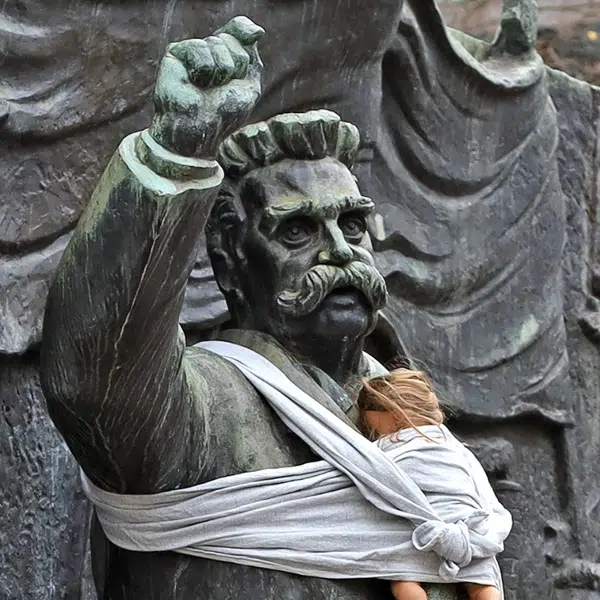
Photo: Carol M. Highsmith Archive, Library of Congress
As protest overtook the streets of Washington D.C. during the summer of 2020, the fence that once stood between the White House and demonstrators at Lafayette Park slowly evolved into a living art exhibit. Though the barricade was originally erected for security purposes, protestors took it upon themselves to convert the barrier into a makeshift gallery wall. As its collection grew, the fence displayed countless Black Lives Matter posters, signs, and artworks created in defiance of the rampant police brutality and racial injustice that led to the murder of George Floyd—and countless other Black men and women who have fallen victim to similarly unjust fates.
The fence was finally taken down early in 2021, and with it, the display that has since become known as the Black Lives Matter memorial. But in the year since its removal, several activists have dedicated themselves to preserving each artifact from the wall—a collection of nearly 800 pieces—recognizing each of them as an important part of American history. As a result of their efforts, and with the help of archivists, now more than 30 artworks that once graced the memorial are available to view in an online exhibit hosted by the Library of Congress. The pieces included in the online display also officially form part of the Library’s collection now.
“[The Library] wants people to see those signs, the messages, and contextualize them with other parts of our collection that talk about similar issues,” says the Library’s head of technical services for the prints and photography division, Aliza Leventhal, who spearheaded the collection efforts.
For the duration of the project, she worked in collaboration with the fence’s de facto curator Nadine Seiler, who had made it her personal mission to guard, protect, and preserve the memorial site. Seiler—who even spent some nights sleeping at the memorial to prevent any overnight vandalism to the site—and several other activists who joined her cause played an integral role in bringing the digital collection at the Library of Congress to life. For her own part, Leventhal had also formed a deeply personal connection with the memorial as she visited the fence daily for eight months, witnessing its profound transformation.
“The signs ranged from crafted works of art either brought from home or created on the site, as well as scrap pieces of paper with hastily written messages,” Leventhal explains. “Every day new signs were showing up, another person sharing their story and adding valuable layers to the ongoing conversation on the fence.” The Black Lives Matter posters in the Library’s collection represent a small portion of that conversation as well as the diversity of voices that contributed to its discourse. “I was more drawn to the humorous protest signs,” says Seiler. “I guess it’s the vein of, ‘If I don’t laugh, I’ll cry.’ For me, it’s taking tragedy of our dehumanization and lightening it so it’s not so heavy on my psyche.”
Now that the fence has been dismantled, the more than 800 signs removed by volunteers are being housed in a storage unit in Washington D.C. The artworks will remain there until they can be scanned by archivists at Baltimore’s Enoch Pratt Free Library, who are working in collaboration with the D.C. Public Library. Once the scanning effort has been completed, the process of gifting the pieces will begin.
According to Seiler, organizers with the D.C. chapter of Black Lives Matter would prefer that the pieces remain in the possession of Black organizations. However, the hope is that wherever they end up, people will recognize their importance and seek to understand the messages behind them. “I don't know what it's going to take, but whoever takes some has to agree to care for them,” Seiler says.
Visit the Library of Congress website to see the pieces in its digital collection available for view online.
In the summer of 2020, Black Lives Matter posters transformed a fence near the White House into a living memorial wall.
Now some of those posters are in the Library of Congress' digital collection.
Library of Congress: Website | Instagram | Facebook | Twitter
h/t: [NPR]
Related Articles:
This New Digital Archive Preserves Black Lives Matter Protest Art From Around the World
Dolly Parton’s Black Lives Matter Statement Is Now a Mural in Nashville
African American Photographer’s Amazing Archive Added to the Library of Congress
5 Iconic Romare Bearden Artworks That Capture 20th Century Black American Life






















































































